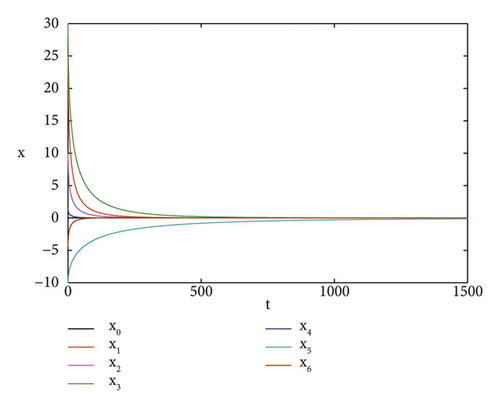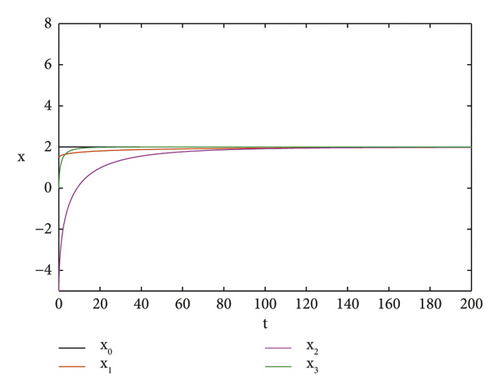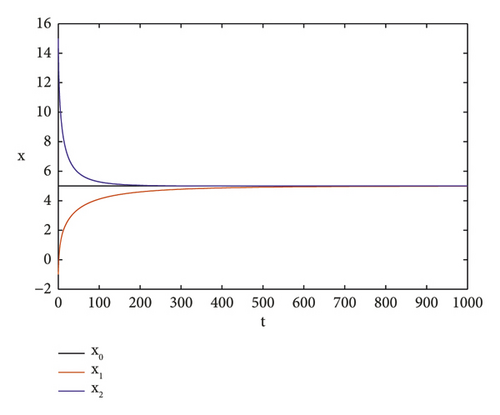Exponential Stability for an Opinion Formation Model with a Leader Associated with Fractional Differential Equations
Abstract
This paper studies the dynamics of an opinion formation model with a leader associated with a system of fractional differential equations. We applied the concept of α-exponential stability and the uniqueness of equilibrium to show the consensus of the followers with the leader. A sufficient condition for the consensus is obtained for both fractional formation models with and without time-dependent external inputs. Moreover, numerical results are provided to illustrate the dynamical behavior.
1. Introduction
Humans and some animals are social animals. Living together as a society requires mutual assistance and generosity, which will lead to happiness. Whether it is a small or a large society, social animals, for instance, a flock of birds, bees, insects, and fish, have a complex thought structure and they tend to have a leader to lead their lives to peacefulness. Some research focuses on the behavior of these social animals, including an all-leader agent-based model for turning and flocking birds [1], the migration of honeybees to a new nest site [2], leadership in fish shoals [3], and the effective leadership and decision-making in animal groups on the move [4]. In these systems, individuals are mutually dependent and communicate some information to their peers in a certain region around them. Many researchers have studied and developed a group of opinion formation models, which have been developed into many approaches. Examples of these approaches are opinion formation models on a gradient [5], opinion formation models based on game theory [6], Boltzmann and Fokker–Planck equations for opinion formation models associated with strong leaders [7], opinion formation models based on kinetic equations [8], agent-based models for opinion formation [9], consensus and clustering in opinion formation on networks [10], and Boltzmann-type control of consensus of the opinion with leaders [11].
In recent years, fractional differential and integral operators have been utilized in various real-world problems and areas of study, such as physical and biological sciences [12], environmental science, signal and image processing, and engineering [13–19]. New generalizations and definitions of the fractional derivative are also of interest by choosing different kernels [20]. In particular, it motivates a generalization of the opinion formation model to involve fractional calculus.
Rather than focusing on the design of an optimal control, we mainly focus on the exponential stability of the solutions and establish some sufficient conditions for the consensus opinion of all agents with the leader x0.
The rest of this paper is organized as follows. In Section 2, we provide some definitions and preliminary results in integral and differential fractional calculus and exponential stability of systems of fractional differential equations. The existence of a unique consensus equilibrium point of fractional opinion formation models associated with a leader will be investigated in Section 3 and Section 4 for the systems described by (4) and (5), respectively. In Section 5, we provide examples and numerical simulations to demonstrate our analytical results.
2. Fractional Calculus Framework
In this section, we briefly outline some notions from fractional calculus that will be used throughout the paper.
Definition 1 (see [23].)For α > 0, the left Caputo fractional derivative of order α is given by
Definition 2 (see [23].)The Riemann–Liouville fractional integral of order α > 0 is given by
Lemma 1 (see [23].)Let α > 0 be a real number. The general solution of the fractional Caputo type differential equation
Lemma 2 (see [23].)For a positive constant α > 0 and y ∈ Cn[0, T], we have
Definition 3 (see [24].)We say the y∗ ∈ ℝm is an equilibrium of system (12) whenever f(t, y∗) = 0 for all t ∈ [0, ∞).
Definition 4 (see [24].)System (12) is α-exponentially stable if there exist two positive constants M > 0 and λ > 0 such that for any solutions x(t) and y(t) of system (6) subject to the initial conditions x0 and y0, respectively, we have
It should be noted that the notion of α-exponential stability concerns the closeness of solutions x(t) and y(t) subject to different initial conditions x0 and y0, respectively, while the definition of the Mittag-Leffler stability in [12] concerns the convergence of a solution x(t) to an equilibrium point.
Lemma 3 (see [17].)If dαx/dtα ≤ dαy/dtα with α ∈ (0,1) and x(0) = y(0), then x(t) ≤ y(t).
Lemma 4 (see [17].)Let W ∈ C[0, ∞) be a function such that dαy/dtα ≤ δW(t), where α ∈ (0,1) and δ is an arbitrary constant. Then, we have
We define the signum function as
3. Stability and Consensus of Fractional Leader-Follower Opinion Formation Model
-
(H1) The functions fi, i = 1,2, …, N are Lipschitz continuous with respect to the second variable on ℝ with Lipschitz constants Li > 0, that is,
() -
for all x, y ∈ ℝ uniformly with respect to t,
-
And another prerequisite for proving results.
-
(H2) The constants ci is positive for i = 1,2, …, N and satisfies
()
Under the Lipschitz condition of the source term (H1), we obtain the existence and uniqueness of the solution to the Cauchy problem (4) from the standard result [25].
Motivated by [24], we prove the following result.
Theorem 1. Under the assumptions (H1) and (H2), system (4) is exponentially stable.
Proof. Let and be the solutions of system (4) subject to the different initial conditions xi(0) = ξi and yi(0) = ζi, i = 1,2, …, N.
Let for i = 1,2, …, N, then . By (4) we get
If is positive, then
if is negative, then
hence,
next, we construct a function W by
we compute the Caputo fractional derivative of W(t) using the assumptions (H1) and (H2) to obtain
it follows that system (4) is exponentially stable.
Next, we assume that the leader’s opinion is kept constant as ξ0 for all time, that is, u(t) = 0 in (4). Let be an equilibrium of (4). Hence, it satisfies the following system
Theorem 2. Assume that (H1) and (H2) hold. Then, system (4) has a unique equilibrium.
Proof. Let ciyi = pi for i = 1,2, …, N. We get from (25) that
consider the map defined by , where and
by the Lipschitz condition (H1), for any p, q ∈ ℝN, we have
We have from (H1) that for i = 1,2, …, N. Hence,
Thus, the map is a contraction. Therefore, has a unique fixed point, showing that system (4) has a unique equilibrium.
The next result shows that all the agents’ opinions are in consensus with the leader.
Theorem 3. Assume that (H1) and (H2) hold. Suppose that fi(t, ξ0) = 0 for t ∈ [0, ∞) and for all i = 1,2, …, N. Then, all agents’ opinions xi(t) of (4) converge to the consensus opinion ξ0.
Proof. The proof follows the same argument as in [22, Theorem 2] where the system is autonomous. We outline the proof when the nonautonomous source term is considered here. Let (x0(t), x1(t), …, xN(t)) be a solution of (4). Since we assume that u(t) = 0, we have that x0(t) = ξ0 is a constant function. Let yi = xi − ξ0 and define gi(t, yi) : = fi(t, yi + ξ0), for i = 1, …, N. Then, system (4) can be written as
we see that for any ,
4. Stability and Consensus of Leader-Follower Opinion Formation Model with Time-dependent External Inputs
In this section, we extend the study to consider a leader-follower opinion formation model with time-dependent external inputs.
Consider the leader-follower opinion formation model with time-dependent external inputs hi(t), i = 1,2, …, N in (5).
We assume the following conditions for the external inputs.
Theorem 4. Assume that (H1), (H2), and (H3) hold. Then, system (5) is exponentially stable. Moreover, for any solution x(t), there exists T ≥ 0 such that
Proof. Let and be the solutions of system (5) subject to the different initial conditions xi(0) = ξi and yi(0) = ζi, i = 1,2, …, N. By setting w∗(t) = y(t) − x(t) and using a similar argument as in the proof of Theorem 1, there exists M > 0 such that
Using assumptions (H1) and (H2), we compute the Caputo fractional derivative of W(t) as
Consider the fractional-order system
It is easily seen that (38) is exponentially stable, so that any solution converges to the unique equilibrium V∗ = w/k, that is
Hence, for any arbitrary ε > 0, there exists T > 0 such that
By Lemma 3, we have W(t) ≤ V(t) with W(0) = V(0). Thus, there exists T ≥ 0 such that for any solution x(t),
We next state the consensus result for an opinion model with time-dependent external inputs.
Theorem 5. Assume that (H1), (H2), and (H3) hold. Suppose that fi(t, ξ0) = 0 for t ∈ [0, ∞) and limt⟶∞hi(t) = 0 for all i = 1,2, …, N. Then, all agents’ opinions xi(t) of (5) converge to the consensus opinion ξ0.
Proof. Let (x0(t), x1(t), …, xN(t)) be a solution of (5). Since we assume that u(t) = 0, the leader’s opinion is a constant function x0(t) = ξ0. Let yi = xi − ξ0 and define gi(t, yi) : = fi(t, yi + ξ0), for i = 1, …, N. Then, system (5) can be written as
it can be seen that gi satisfies Lipschitz continuity condition as
since limt⟶∞hi(t) = 0 for i = 1,2, …, N, we have |hi(t)| ≤ ε whenever t is sufficiently large for all i = 1,2, …, N. Hence, if we consider (37) for some sufficiently large time , then the bound of hi in (H3) can be chosen as an arbitrary small ε. Consequently, we obtain
As ε > 0 was arbitrary, we have yi(t)⟶0 as t⟶∞. Consequently, we obtain the consensus opinion limt⟶∞xi(t) = ξ0 for every i = 1, …, N.
5. Numerical Examples
In this section, we give examples of the fractional opinion formation model of order 0 < α < 1 to illustrate the dynamics of the system. In particular, we demonstrate through numerical examples that consensus opinion can be achieved when the assumptions of our results are satisfied.
Example 1. Consider the following system of opinion formation model with leader
In this system of opinion formation model (47) with leader x0(t) = ξ0 = 0, we set a11 = 0.06, a12 = −0.01, a16 = −0.02, a21 = 0.03, a22 = −0.02, a24 = −0.02, a33 = −0.01, a34 = 0.01, a44 = 0.03, a45 = −0.02, a46 = 0.02, a52 = 0.05, a53 = −0.09, a56 = 0.08, a61 = 0.03, a62 = 0.05, a63 = 0.09, a66 = 0.02, c1 = 0.3, c2 = 0.3, c3 = 0.2, c4 = 0.4, c5 = 0.1, and c6 = 0.4, respectively. We see that fi(t, ξ0) = 0, limt⟶∞hi(t) = 0 and Li = 1 for i = 1,2, …, 6 so that all the assumptions of Theorem 5 are satisfied. Hence, the leader-follower for opinion formation model (47) is exponentially stable. The states of x0, x1, x2, x3, x4, x5 and x6 of system (47) converges to a consensus state (0,0,0,0,0,0,0) as shown in Figure 1 for α = 0.5.

Example 2. Consider the leader-follower opinion formation model
In this system of opinion formation model (48) with leader x0(t) = ξ0 = 2, we set a11 = −0.06, a12 = 0.01, a13 = −0.04, a21 = 0.01, a22 = 0.01, a23 = −0.02, a31 = 0.06, a32 = −0.2, a33 = 0.01, c1 = 0.2, c2 = 0.4, c3 = 1, respectively. We see that f(t, ξ0) = 0, limt⟶∞hi(t) = 0 and Li = 1 for i = 1,2,3 so that all assumptions of Theorem 5 are satisfied. Hence, the leader-follower for opinion formation model (48) is exponentially stable. The states of x0, x1, x2, and x3 of system (48) converges to a consensus state (2,2,2,2) as shown in Figure 2 for α = 0.8.

Example 3. Consider leader-follower for the opinion formation model

6. Discussion and Conclusion
We study the exponential stability of a leader-follower opinion formation model given by the system of nonlinear fractional differential equations. We mainly focus on the sufficient conditions for a consensus opinion of the system when time-dependent inputs are involved. In particular, under the Lipschitz continuity of the source terms, the boundedness condition on the interaction of agents, and the boundedness of external inputs, we apply the concept of α− exponential stability to prove the consensus of the followers with the leader. Our main theoretical result is illustrated by a numerical model to verify that consensus opinion can be achieved. The result is complementary to the optimal control problem for the leader-follower opinion formation model where external control is added to drive all agents’ opinions to consensus, for example, in [21, 22]. A general framework for α-exponential stability can also be considered for fractional-order neural networks as in [24]. In many real-world phenomena, a group of agents can be described by a network where the information exchange between agents is represented by some weight. The results of this paper could be applied to obtain sufficient conditions for the system that ensures consensus with the leader.
Conflicts of Interest
The authors declare that they have no conflicts of interest.
Acknowledgments
The first author was supported by the Kanchanaburi Rajabhat University. The second author was supported by the King Mongkut’s University of Technology Thonburi.
Open Research
Data Availability
No data were used to support this study.




